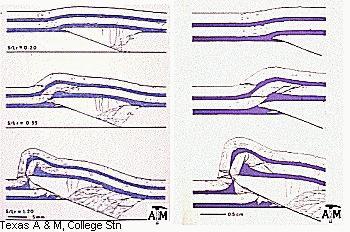THRUST FAULTS
A THRUST FAULT is a map scale coneractional fault. This definition has no value of dip mentioned nor are amounts of slip specified. Central to the definition is a 'contraction fault' (Norris 1958) which shortens an arbitrary datum plane (normally bedding). A. W. Bally (Shell Oil Co., Houston) favoured the term 'listric reverse fault', but this term does not apply to such steep angled thrusts as the Wind River Uplift (see Brewer et al. 1981).
In the context of 'nappe' displacement there also seemed to be general agreement to avoid the 5 km limitation in any definition. Professor H. P. Laubscher (Basel) noted that tbe term 'nappe' historically refers to a thrust mass or thrust sheet of a certain lithology which characterizes a palaeo-geographic affiliation (e.g. facies belts of the 'Alpine geosyncline'). He pointed out that in certain contexts (e.g. the Alps) it is more meaningful to refer to 'nappes' rather than to the thrusts (often many) which separate them (e.g. prealpine nappes). The following definition is, therefore, suggested for a thrust nappe.
A THRUST NAPPE is an allochthonous tectonic sheet which has moved along a thrust fault. Professor Dennis remarked that the link
ing of tectonic napPes with recumbent folds is well known in the context of Alpine tectonics. T. Emmett (University of Newcastle U.K.) suggested that the term 'nappe' be reserved for structures which showed large-scale inversion of strata-a feature often associated with nappes which perhaps initiate as recumbent folds. It may be, therefore, appropriate to define 'fold nappe' in the following manner. 'A FOLD NAPPE' is an allocthonous tectonic unit which exhibits large-scale stratigraphic inversion and may have initiated from large recumbent folds. The underlying limbs of these folds may be sheared out into thrust faults.
Central to the suggested definition of a thrust and implied in that for thrust nappes is the concept of a contraction fault. Norris (1958) defines a 'contraction fault' as a fault which shortens bedding. Its opposite-an 'extemion fault' extends bedding. fn more complex and highly deformed terranes, bedding may not be an appropriate datum plane and hence it is probably best to leave the definition of these types of faults to those given below.
A 'CONTRACTION FAULT' is a fault which shortens an arbitrary datum plane. Note that this plane is normally bedding (el. Norris 1958) but in the case of thrusts developed in crystalline rocks recognition of bedding may be more difficult. Conversely to the definition out
lined above.
An EXTENSION FAULT is a fault which extends an arbitrary datum plane. Professor R. Price cnmments that in the case of gravity glide (slide) structures the faults change character from being extensional at the trailing edge of the structure and contractional at the leading
edge (see also Mandl & Crans, this volume).
Listric Faults
Considerable discussion centred on the use of 'listric' in describing faults which are concave
upwards and whose plane flattens out at depth,
see Bally and Mandl & Crans, this volume). A. W. Bally has suggested the following definitions:
REVERSE LISTRIC FAULT (RLF) is a curved fault (concave upwards) in which, the
steep-often sub-vertical segment is a high angle
reverse fault, the middle segment is a medium
angle reverse fault and the sole is a bedding
plane fault. In both the steep and middle seg
ments, older rocks overlie younger rocks
whereas there is little or no repetition of beds hy the sole fault.
LISTRIC NORMAL FAULT (LNF) is a
curved fault (concave upwards) which may be
divided into high angle normal fault, medium angle normal fault and bedding plane or sale fault segments. With the high and medium angle normal faults stratigraphic section is omitted and younger rocks overlie nlder rocks.
Other Pertiuent Definitions
It is perhaps appropriate to provide a short glossary of terms used in the contributions to this volume. The suggested definitions are a compilation of concepts expressed in both the verbal and written discussion.
KLIPPE-A small detached and isolated portion of a nappe or thrust sheet.
TECTONIC SLIDES are faults that form in metamorphic conditions in metamorphic orogenic belts. This term (suggested by D. Hutton, Trinity College, Dublin) does not imply any geometrical/movement sense (see also Hutton, this volume). Rich (1934) first proposed the concept of a
ramp to describe thrust faults with a staircase geometry. He noted that long bedding plane thrusts in incompetent units (FLATS) were joined by short steep angle thrusts (RAMPS) which cut up section throngh the more competent units, hence a staircase geometry.
FLATS are bedding plane thrust segments within a stepped thrust plane. (i.e.) The thrust plane is parallel to the datum plane.
RAMPS are thrusts which cut up stratigraphic section between FLA TS in a stepped thrust plane. Excellent examples of this staircase geometry are shown in the sections of Price (this volume).
DUPLEX is a thrust sheet (mass) which is bounded by a 'fioor thrust' and a 'roof thrust' Often, duplex structures are imbricated. Blind thrusts are those below the erosion surface but their presence is indicated by shortening in the overlying sequence which is achieved by disharmonic detachment folding.

Thrust faults